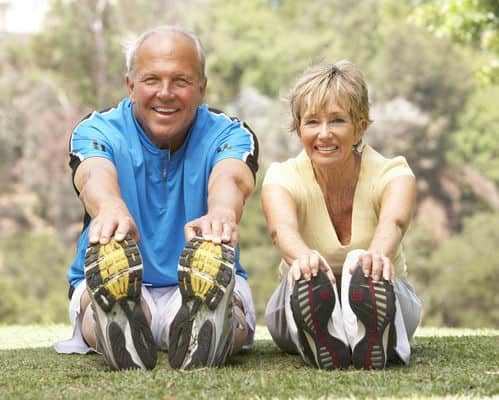

I remember as a kid my “Uncle Joe” (actually just a close family friend) was the most popular adult in the neighborhood. He enjoyed this stature because he was extremely fit and capable of playing ball with the neighborhood kids for hours on end, long after the other fathers had retired to the porch for some rest and refreshment. I remember the day I started worrying about him. My dad was telling my mom that he thought Joe was crazy – that he should quit all this running around before he has a heart attack. Uncle Joe was about 40 at the time and it scared me to think of him dying. And I believed my father, not only because he was my dad, but because all of the parents in the neighborhood agreed with him.
That was the prevailing attitude of the day. Exercise was for young people. Back then, when you were over the age of 30, you were supposed to grow up and then grow old. Exercise didn’t fit into those parameters and health nuts like Joe were playing with fire. Funny thing about Uncle Joe – he never did have that heart attack. He played competitive hockey until well into his 60s. When he took up tennis in his 50s he quickly became one of the dominant amateur players in the county. With the exception of a few days to recover from colon surgery, he exercised every day of his life, which went deep into his 70s until he was felled by colon cancer.
Uncle Joe was my hero and role model and I wanted to be like him. I was not then nor will I ever be the extraordinary athlete that he was, but I think I have lived up to his example of living a vibrant active life, made possible by a commitment to good nutrition and regular, vigorous exercise. The older I get, the more convinced I am that the old way of thinking that, at this stage of my life, would have me taking a daily walk for my exercise is all wrong. There is a growing body of research that supports this belief.
Exercise Works At Any Age
Numerous studies over the last 30 years have indicated that exercise throughout life is beneficial and cannot only extend life, but can help people in their golden years remain active and independent to a greater age than the sedentary population. A recent study performed in Israel found that active 85 year-olds had a 3-year survival rate triple that of their sedentary counterparts. In addition, they demonstrated markedly less depression and loneliness and a higher capability to perform activities of daily living.
Other studies have shown that even people in their 80s and 90s will respond to strength training by developing enhanced strength and mobility. When you combine these findings with those of the aforementioned Israeli study a picture begins to form of a population of people in their 80s and 90s who live independent, active lives. Having spent a fair bit of time treating patients in nursing home facilities, I can tell you that fit, active and independent is the way I want to live out the last years of my life. It’s not currently the primary reason that I keep myself fit, but as the years roll by, it gains importance as a motivator. But, you might be thinking that it is easy for me; I have never been too far out of shape, and I don’t have to worry about the risks of starting an exercise program later in life. Well, it’s not easy for me. It takes commitment and hard work, but I understand how some might be hesitant to start exercising again, or for the first time if they are over the age of 40. Let me assure you. . .
It’s Never Too Late to Start
The truth is that the research shows even at an advanced age, beginning an exercise program that includes cardio and strength training will have a significant benefit on overall health, well being and vitality. One study demonstrated improvements in blood pressure, upper and lower body strength, hip and shoulder mobility and greater agility, balance and coordination. All good things to have and hold as the birthday cards pile up. It’s true though that the older you are when you start exercising again (or for the first time) it takes a little more thought and preparation than is required for the younger crowd. Here are a few tips for getting a safe, effective jump back into the pool of healthy living through exercise:
- Get a checkup with your doctor. Discuss your exercise plans and any necessary precautions that should be taken.
- Start slowly – give your body a chance to acclimate to exercising again.
- Be consistent – stick to your plan.
- Improve your diet – an exercising body requires high quality fuel.
- Cross train – use a variety of exercises and equipment. Changing things up improves results and minimizes boredom.
- Get help – most of the challenges of beginning an effective exercise program can be overcome by employing the services of a certified fitness training professional. He/she will help you use all of the abovementioned tips and much more. To get the best bang for your buck, find a trainer who offers a group fitness training program. Exercising with a group of “regulars” will help you develop a community of like-minded people. This will help to motivate you to get there and get the most out of each session.
I remember seeing the late legend, Jack Lalanne perform a feat of strength on his 70th birthday. He towed a string of 70 boats, one for each birthday, using only his own power. He towed the boats in water. He was swimming. Jack was one of my idols, and he was a freak. He lived to the age of 96 and was seen working out the day before he died. But, you don’t have to leap tall buildings in a single bound to have an active, vibrant, independent life well into your dotage. And the best shot you have at achieving that is to ask your body to start doing the physical work it was born to do as soon as possible. Do it. Start exercising today, and keep it up for the rest of your life. You won’t regret it. I promise.





Thank you for the article! I’m 59 and ready to return to the gym after doing nothing for 3 years of retirement. I’ve been wondering if I was “too old”. Thank you!!
I am 62 and have been in the gym for years and there are many more like us in there trust me
I will now start to work out again! Thanks!!!